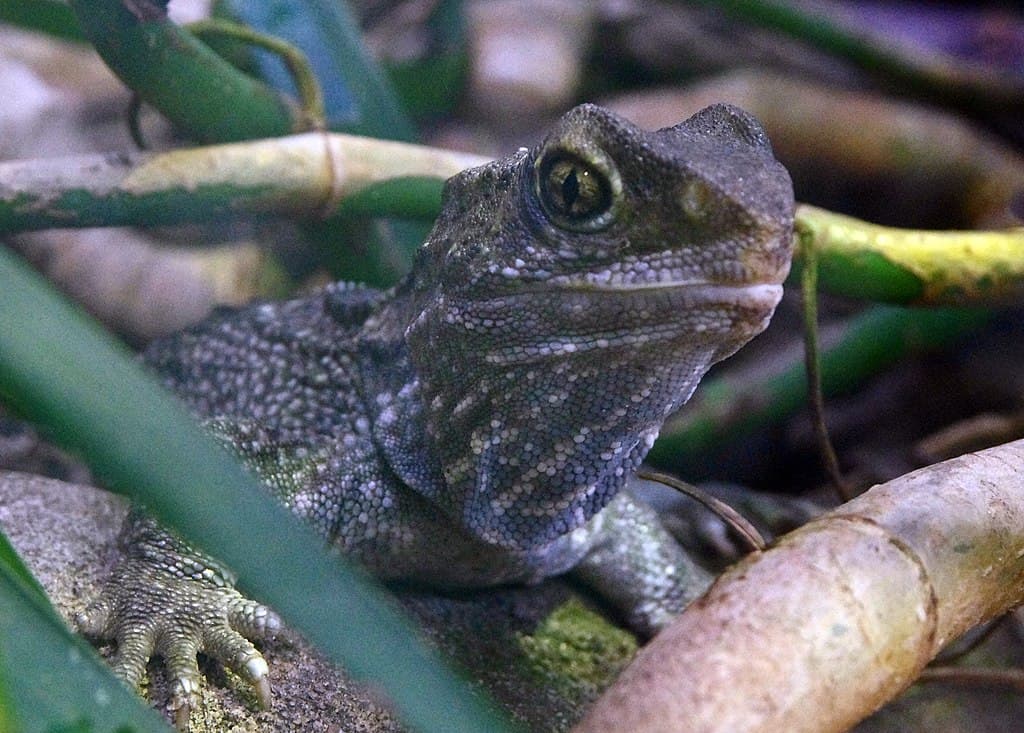With his three little eyes, Henry, the world’s oldest living tuatara first emerged from his burrow on unscathed when he was 35. It was a miracle he had survived predators such as birds, rats, and cannibalistic adult tuatara to eventually get to his adult size. Weighing 1 kg and a half meter in length, Henry survived decades more and today he is 130 years old making him a unique specimen of New Zealand’s endemic wildlife.
A Century-Old Icon of New Zealand

In the lush, secluded corners of Queens Park, Invercargill, New Zealand, lives one of the country’s oldest and most beloved residents—Henry the Tuatara. Now believed to be between 110 and 130 years old, Henry has lived a remarkable life, becoming a cherished symbol of New Zealand’s wildlife conservation efforts and an enduring figure in the hearts of New Zealanders. But Henry’s story is not just about longevity—it’s also about his surprising transformation from a solitary reptile to a celebrated icon.
A Living Fossil from the Age of Dinosaurs

New Zealand is home to around 150 species of reptiles, but none are quite like the tuatara. Although they resemble lizards, tuatara are the sole surviving members of the ancient order Sphenodontia, which roamed the Earth alongside dinosaurs over 225 million years ago.
Tuataras Have a Third Eye

This fascinating reptile boasts several unique traits, including a parietal “third eye” on the top of its head that can detect light. Additionally, tuatara grow slowly, can live up to 200 years, and have been known to reproduce even past the age of 100.
Revered by the Māori

For the Māori people, tuatara are considered a taonga (treasured) species, appearing on coins, stamps, and in children’s literature across New Zealand. But despite their revered status, tuatara populations have dwindled and now primarily survive on predator-free offshore islands. Henry, however, resides in a state-of-the-art enclosure in Queens Park, one of the few places on the mainland where tuatara can live in a secure environment.
A New Life in Invercargill

Henry’s journey began decades ago on Stephens Island, a remote location at the northern tip of New Zealand’s South Island. After spending around 80 years in the wild, Henry was relocated in 1970 to Invercargill’s Southland Museum, where he became a public figure known for his age and enigmatic nature. His home at Queens Park was specially designed to replicate the tuatara’s natural environment, complete with mossy logs and man-made burrows. This facility is the only one of its kind in New Zealand, allowing Henry and other tuatara to thrive in a controlled yet natural setting.
Henry Was a Grumpy Guy in His Early Years

For nearly 17 years, Henry was known for his grumpy and irascible temperament, often lashing out at other tuatara. His antisocial behavior was so extreme that he had to be isolated from his peers. In the 1980s, when handlers tried to pair him with a female tuatara named Mildred, he bit off her tail—not once, but twice. But in 2007, a pivotal moment changed everything. A cancerous tumor was discovered and removed from Henry’s genitals, drastically altering both his personality and his libido. Suddenly, Henry became more sociable, and in 2008, at the age of 111, he fathered offspring for the first time, making international headlines.
Docile During Winter, Frisky in Summer

During the cooler months, Henry remains relatively inactive, conserving his energy and rarely eating. But when summer arrives, he becomes more active, venturing out of his burrow to sunbathe and hunt for food. Despite his advanced age, Henry is still quick and agile, traits that have earned him the reputation of a “killing machine” among those who care for him.
He Has Two Wives

Today, Henry shares his enclosure with two female companions, Mildred, and Lucy, both around 70 years old. Together, they enjoy the comforts of their meticulously maintained environment, where their diet and health are closely monitored by Dawson and her team.
A Lasting Legacy

As Henry nears the 50-year mark of living in captivity, his legacy continues to inspire both scientists and the public. Tuatara are one of the longest-living species on Earth, with some individuals reaching 200 years of age. Henry, who has lived through significant environmental changes and outlived many human generations, is a testament to the resilience and longevity of these ancient reptiles. For New Zealanders, Henry is much more than just a reptile—he is a symbol of the country’s dedication to wildlife conservation and a beloved figure that bridges the gap between ancient history and the modern world. watch a video of Henry.
- 12 Foods in Your Pantry That Could Help Your Dog Live Longer - August 13, 2025
- 10 Spirit Animals Symbolic of Zodiac Sign Virgo - August 13, 2025
- 10 Extraordinary Animals Known for Their Healing Powers - August 11, 2025

